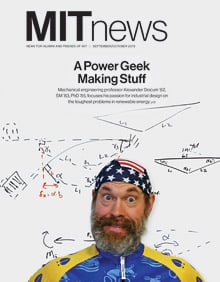Letters
An Inspiring Story
Your story about Amos Winter (“The Accidental Humanitarian,” July/August 2013) brought to mind comments I’d recently read by a technologist (can’t remember who, but it might even have been in your magazine) who encouraged young people with technology skills to stop inventing more dating sites, saying that too much innovation was built by rich, developed-world types for their own cohort because they couldn’t envision the problems of others and that there were many, many mundane areas that could benefit from technology, innovation, and efficiency. Thanks for printing this inspiring story about someone doing just that and, even better, inspiring others in his classes. I love Amos and I read his story to my six-year-old son.

Lisa Heller, SM ’93, MCP ’93
Brooklyn, New York
Reducing Vehicle Emissions
Having served as the faculty advisor to the Clean Air Car Race in 1970, I was pleased to see the story about that historic race in MIT News (“A Clean Race,” September/October 2013).
Two years after the race, I became director of MIT’s Sloan Automotive Laboratory, and I have been studying engine performance and automotive emission control ever since. So I can report that we have indeed drastically cut air pollutant emissions since the 1970s, thanks to government regulations and steady progress on engine catalysts. But the United States has plenty of work still to do to reach the goal climate scientists set a few years ago: a 60 to 80 percent reduction in vehicle greenhouse-gas emissions from current levels by 2050. (U.S. greenhouse-gas emissions have been essentially constant over the past decade.) My team’s research indicates that to even come within shouting distance of this target, it’s critical to develop alternative approaches—fuel cells using hydrogen, plug-in hybrid electric vehicles, and biofuels, along with reductions in driving. These approaches would have to be successfully brought into use in a big way, and as soon as is feasible. That’s an incredibly challenging task.
Many see combustion engines on the way out and electric cars as the promising fix, but that’s not clear to me. Tesla has succeeded in captivating the media because they promise a zero-emission solution. But the solution won’t come from cars that only a small section of the population buys. What we have to do is make the entire U.S. driving fleet of 250 million vehicles steadily better over time.
If we want to reduce greenhouse-gas emissions from transportation substantially, we will need a multifaceted approach, featuring aggressive improvements to mainstream engine technology and hybrids, development and implementation of radically different solutions, and incentives to change human driving behavior.
To safeguard our planet, all of us will have to strongly support these initiatives.
John Heywood, SM ’62, PhD ’65
MIT Professor of Mechanical Engineering
Cambridge, Massachusetts
I enjoyed the story about the clean Air Car Race, which took place when I was on campus. But the story says that MIT president James Killian encouraged the race’s organizers, telling them that he needed a success story. What ever happened to Howard Johnson?
Dr. Killian was president from 1948 to 1959.
HoJo was at the helm in my era (1966–1971) and was always willing to say hello and talk in the corridors—a good man.
Mike Linehan ’71
Natick, Massachusetts
Editor’s note: You are correct. While Killian did indeed spearhead the race, by that point he was the former president and was serving as chairman of the MIT Corporation. Howard Johnson was president at the time of the race.
Measuring Sports
I enjoyed your article on sports analytics (“Rewriting the Playbook,” September/October 2013). I especially liked the conclusion, which quoted sports consultant and former MIT blackjack team member Jeff Ma saying that sports analysts have to keep asking themselves if their models still apply. Analyzing sports is a lot like trying to measure chemicals in a swimming pool while someone is dumping more chemicals in at the opposite end. Will certain chemicals produce false positives for other chemicals and throw off all the measurements?
Actively changing the system that you’re measuring—whether you’re talking about swirling chemicals or the never-ending flow of sports statistics—requires frequent measurements as well as an understanding of how your changes to the system affect the tools being used to measure.
Jeff Dzado
Bealeton, Virginia
Keep Reading
Most Popular
Large language models can do jaw-dropping things. But nobody knows exactly why.
And that's a problem. Figuring it out is one of the biggest scientific puzzles of our time and a crucial step towards controlling more powerful future models.
How scientists traced a mysterious covid case back to six toilets
When wastewater surveillance turns into a hunt for a single infected individual, the ethics get tricky.
The problem with plug-in hybrids? Their drivers.
Plug-in hybrids are often sold as a transition to EVs, but new data from Europe shows we’re still underestimating the emissions they produce.
Google DeepMind’s new generative model makes Super Mario–like games from scratch
Genie learns how to control games by watching hours and hours of video. It could help train next-gen robots too.
Stay connected
Get the latest updates from
MIT Technology Review
Discover special offers, top stories, upcoming events, and more.